Article: “Classics Gather Where Lindbergh’s Flight Began”
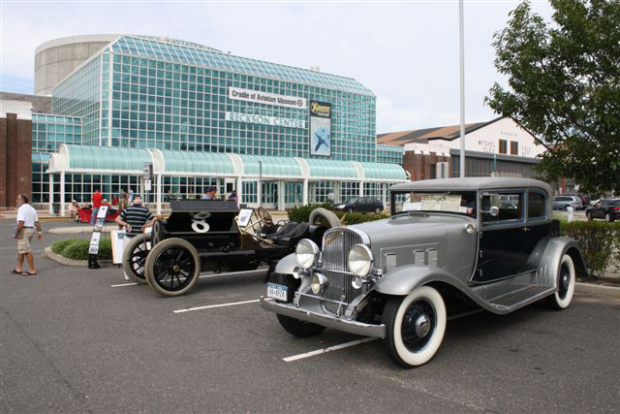
Author Greg Merksamer has written an article on the Second Annual Cradle of Aviation Museum Car Show held on September 25, 2011. Over 90 classic and vintage cars participated in the Cradle of Aviation Museum Car Show hosted by the Long Island Sound Region of the Classic Car Club of America.
CLASSICS GATHER WHERE LINDBERGH’S FLIGHT BEGAN
story & photos by Gregg D. Merksamer, (845) 986-6857 or [email protected]
The theorem that vintage autos and early aircraft go together like peanut butter and jelly was well-proven at the Second Annual Cradle of Aviation Museum Car Show, which took place at Mitchel Field (one “L”) in Garden City, Long Island, New York on September 25th, 2011. This venue, situated at “ELEV. 90 FT.” according to the signage prominently painted on one of the World War II era aircraft hangars, is only about a mile south and east of Roosevelt Field, where Charles Lindbergh commenced his 1927 solo flight to Paris, and is easily-accessed from the myriad parkways built by Robert Moses on Long Island.
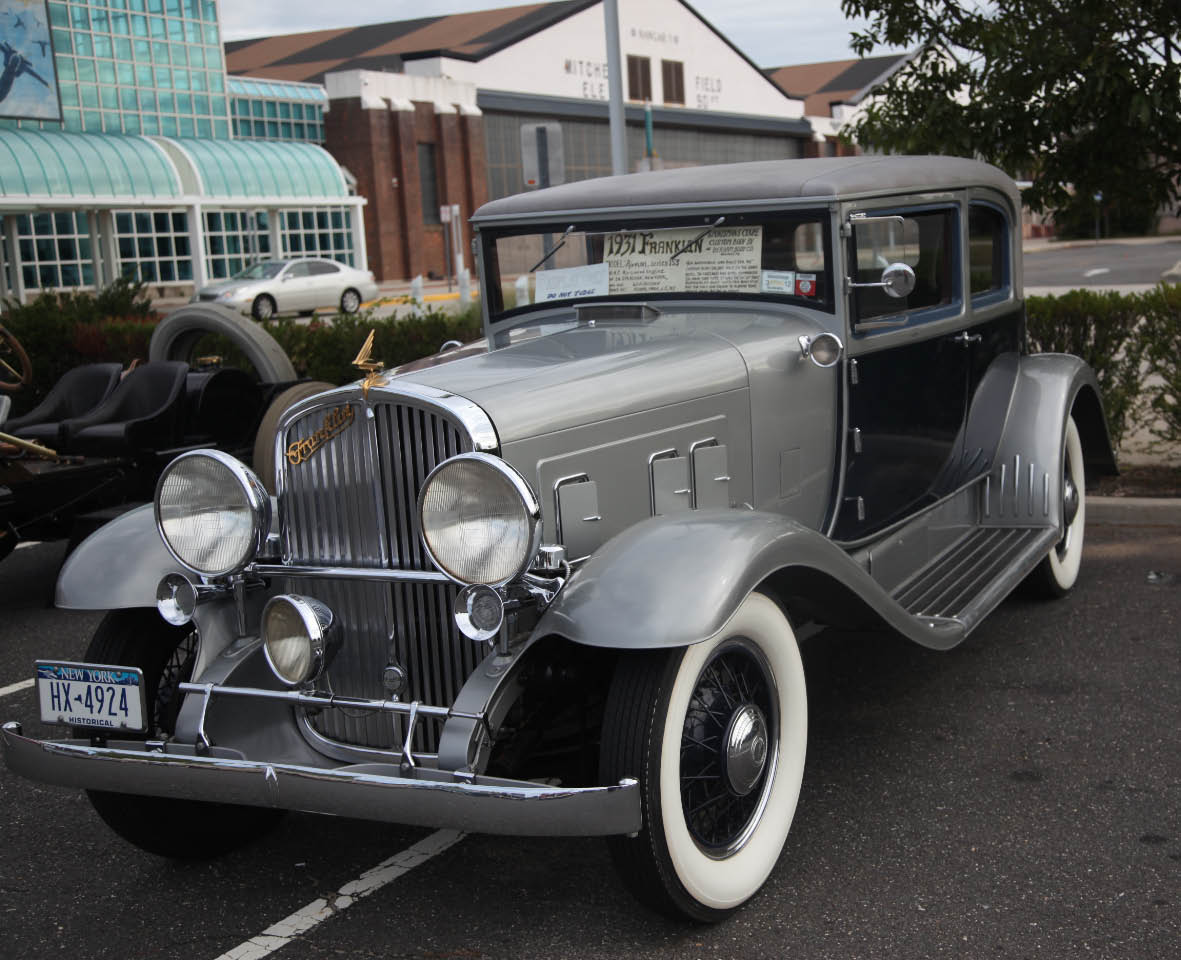 Though the total turnout suffered from the re-scheduling of a half-dozen other area car shows originally slated for the weekend Hurricane Irene devastated the region, this gave spectators added time to fully-scrutinize and appreciate the impressively large contingent of 1930s luxury models assembled by the Long Island Sound Region of the Classic Car Club of America. Given that air-cooled Franklins from upstate Syracuse were a favorite car of Lucky Lindy, cognoscenti couldn’t ignore the 1931 Airman Series 153 Sportsman’s Coupe owned since 1973 by Walter Gosden of Floral Park, N.Y., which sold new for a substantial $5,800 and was the only known survivor of three examples bodied by Derham of Rosemont, Pennsylvania.
Though the total turnout suffered from the re-scheduling of a half-dozen other area car shows originally slated for the weekend Hurricane Irene devastated the region, this gave spectators added time to fully-scrutinize and appreciate the impressively large contingent of 1930s luxury models assembled by the Long Island Sound Region of the Classic Car Club of America. Given that air-cooled Franklins from upstate Syracuse were a favorite car of Lucky Lindy, cognoscenti couldn’t ignore the 1931 Airman Series 153 Sportsman’s Coupe owned since 1973 by Walter Gosden of Floral Park, N.Y., which sold new for a substantial $5,800 and was the only known survivor of three examples bodied by Derham of Rosemont, Pennsylvania.
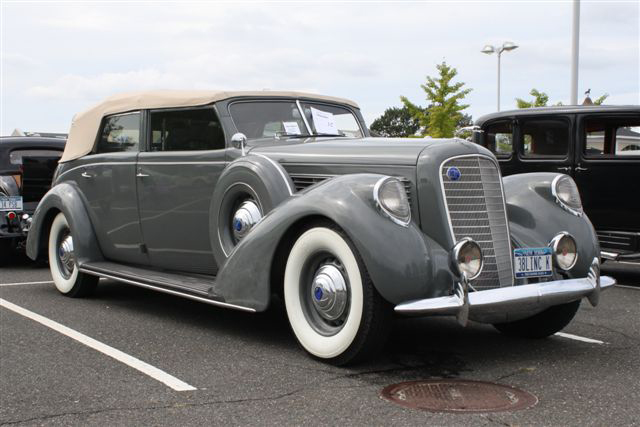 Ed Deutsch, a regional CCCA Director who celebrated his 90th birthday last January, rebutted the Lincoln Series K V-12’s reputation for “Mack truck” handling by bringing his battleship gray, LeBaron-bodied 1938 Convertible Sedan from Bellmore, N.Y., while show co-founder William J. Funk - a former airplane mechanic from Oceanside, N.Y. - reported he’d personally fabricated the water pump and wiper knobs on his 1933 Pierce-Arrow V-12 1236 Club Sedan.
Ed Deutsch, a regional CCCA Director who celebrated his 90th birthday last January, rebutted the Lincoln Series K V-12’s reputation for “Mack truck” handling by bringing his battleship gray, LeBaron-bodied 1938 Convertible Sedan from Bellmore, N.Y., while show co-founder William J. Funk - a former airplane mechanic from Oceanside, N.Y. - reported he’d personally fabricated the water pump and wiper knobs on his 1933 Pierce-Arrow V-12 1236 Club Sedan.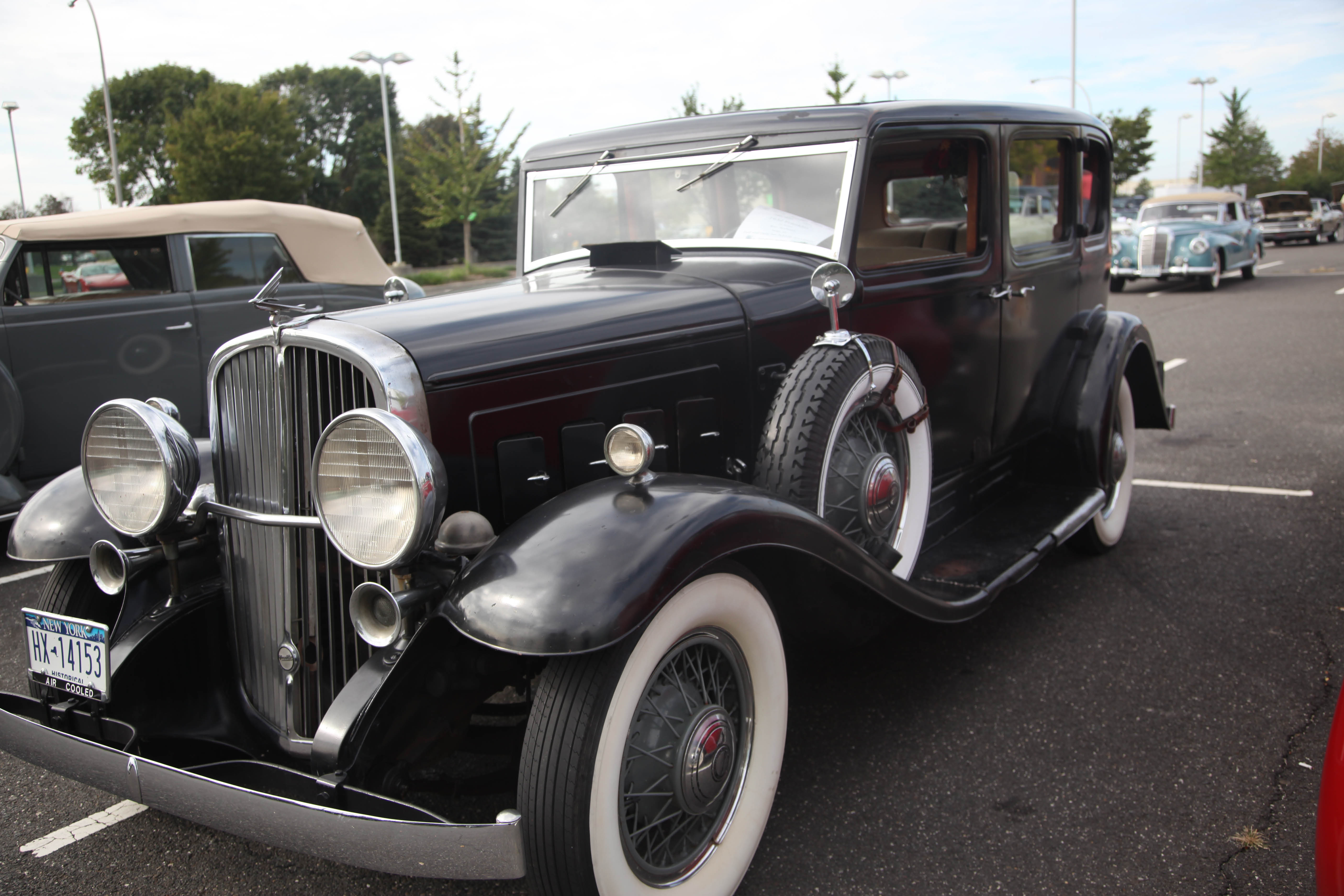
 Best-of-Show in this exalted company ultimately went to Bob Blakeman’s Fleetwood-bodied 1932 Cadillac V-16 Limousine Brougham, a truly-imposing town car weighing in at 5,935 pounds on its tremendous, 149-inch wheelbase chassis. “I bought it six years ago in Arizona at one of the showrooms you patronize if you like older cars,” recalled the Valley Stream, Long Island resident. “It wasn’t cheap, but the price was fair and you could pull a bus out of a ditch with this many cylinders.”
Best-of-Show in this exalted company ultimately went to Bob Blakeman’s Fleetwood-bodied 1932 Cadillac V-16 Limousine Brougham, a truly-imposing town car weighing in at 5,935 pounds on its tremendous, 149-inch wheelbase chassis. “I bought it six years ago in Arizona at one of the showrooms you patronize if you like older cars,” recalled the Valley Stream, Long Island resident. “It wasn’t cheap, but the price was fair and you could pull a bus out of a ditch with this many cylinders.”
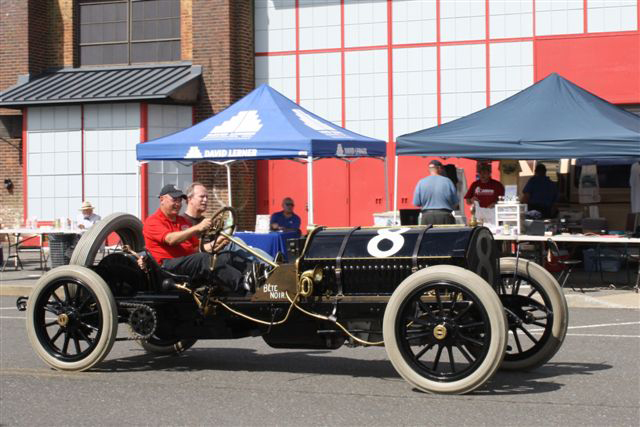 Since the aircraft inside the Cradle of Aviation Museum - ranging from a World War I Curtiss “Jenny” biplane to the Long Island-built Apollo Lunar Module - were strictly static displays, truly fortunate were the handful given rides behind the thundering, 680.6 cubic inch six powering Howard Kroplick’s Alco “Bête Noir” (“Black Beast”) racer, which had taken Harry Fortune Grant to victory in the 1909 and 1910 Vanderbilt Cups before competing in the inaugural Indianapolis 500 staged in 1911. Though a broken bearing retired it on the 52nd lap, two-time winner Emerson Fittipaldi got drive it at the head of the parade lap preceding this year’s Centennial Edition. “When the Marmon Wasp that won the first 500 broke a rod after 500 yards,” Kroplick recalled of his trip in the mechanic’s seat that day, “we held off passing it out of respect until a race official came up to us and said ‘we need you to take the lead.’ I told Emo ‘I’ve been waiting a hundred years to do that.’ After returning to the starting line, the first person to congratulate us was Mario Andretti. For a split second, I’d thought we’d crashed and I was in Heaven.”
Since the aircraft inside the Cradle of Aviation Museum - ranging from a World War I Curtiss “Jenny” biplane to the Long Island-built Apollo Lunar Module - were strictly static displays, truly fortunate were the handful given rides behind the thundering, 680.6 cubic inch six powering Howard Kroplick’s Alco “Bête Noir” (“Black Beast”) racer, which had taken Harry Fortune Grant to victory in the 1909 and 1910 Vanderbilt Cups before competing in the inaugural Indianapolis 500 staged in 1911. Though a broken bearing retired it on the 52nd lap, two-time winner Emerson Fittipaldi got drive it at the head of the parade lap preceding this year’s Centennial Edition. “When the Marmon Wasp that won the first 500 broke a rod after 500 yards,” Kroplick recalled of his trip in the mechanic’s seat that day, “we held off passing it out of respect until a race official came up to us and said ‘we need you to take the lead.’ I told Emo ‘I’ve been waiting a hundred years to do that.’ After returning to the starting line, the first person to congratulate us was Mario Andretti. For a split second, I’d thought we’d crashed and I was in Heaven.”
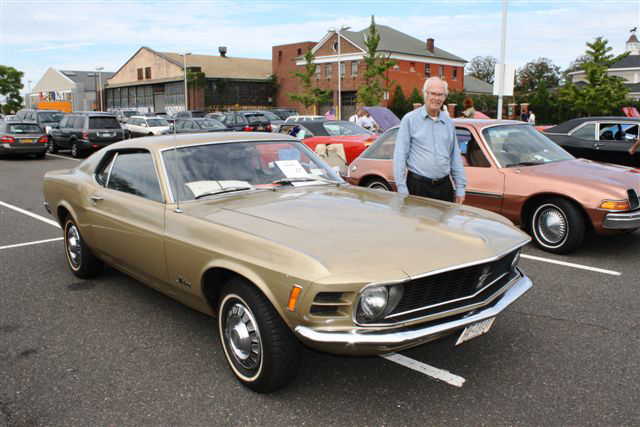 Proof one didn’t need a high-end classic to turn heads at the Cradle was rendered by Bill Schwartzberg, who had purchased his 1970 Mustang Sportsroof brand new 94,390.1 miles earlier from Monahan Ford of Flushing, Queens, N.Y. Having paid $3,577.50 including sales tax and such worthwhile options as front disc brakes, heavy-duty suspension and a 302 cubic inch 2-barrel V-8 linked to 4-speed, Hurst-shifted manual gearbox, he detailed “The Light Metallic Gold paint was not popular on Mustangs - I saw it on a Galaxie in the showroom, and it was also popular on Torinos. When I bought it, I thought I was going to keep it five years, but that was when the Mustang II came out so I said ‘no way.’” Another relatively-modest vehicle that made a strong connection with show-goers, quite literally, was a York-Hoover-bodied 1948 Chevrolet Thriftmaster 3100 telephone service truck owned by George Anderson, who worked as an installer/repairman for the Bell System and its successors from 1963-2001. “When I first started,” he explained, “I had a truck just like this, though the cab portion was a 1955 Dodge.” A period ad displayed by his left front fender confirmed “it’s got all the right tools, telephones and hardware from 1948,” and there were detailed diagrams inside each door to ensure each drawer remained impeccably organized. Thumbing a 1950 copy of BELL SYSTEM PRACTICES, Anderson emphasized “they’d tell you how many of each type of screw they wanted on the truck and where they wanted it, so matter whose truck you used, things would be in the same place.”
Proof one didn’t need a high-end classic to turn heads at the Cradle was rendered by Bill Schwartzberg, who had purchased his 1970 Mustang Sportsroof brand new 94,390.1 miles earlier from Monahan Ford of Flushing, Queens, N.Y. Having paid $3,577.50 including sales tax and such worthwhile options as front disc brakes, heavy-duty suspension and a 302 cubic inch 2-barrel V-8 linked to 4-speed, Hurst-shifted manual gearbox, he detailed “The Light Metallic Gold paint was not popular on Mustangs - I saw it on a Galaxie in the showroom, and it was also popular on Torinos. When I bought it, I thought I was going to keep it five years, but that was when the Mustang II came out so I said ‘no way.’” Another relatively-modest vehicle that made a strong connection with show-goers, quite literally, was a York-Hoover-bodied 1948 Chevrolet Thriftmaster 3100 telephone service truck owned by George Anderson, who worked as an installer/repairman for the Bell System and its successors from 1963-2001. “When I first started,” he explained, “I had a truck just like this, though the cab portion was a 1955 Dodge.” A period ad displayed by his left front fender confirmed “it’s got all the right tools, telephones and hardware from 1948,” and there were detailed diagrams inside each door to ensure each drawer remained impeccably organized. Thumbing a 1950 copy of BELL SYSTEM PRACTICES, Anderson emphasized “they’d tell you how many of each type of screw they wanted on the truck and where they wanted it, so matter whose truck you used, things would be in the same place.”
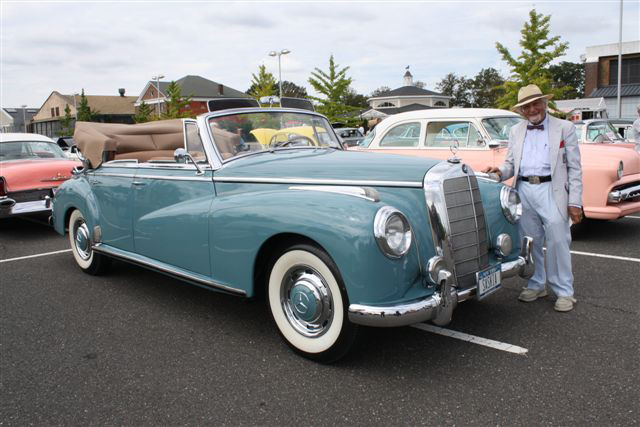 As it was one of only 57 made, one of the top head-turners among the foreign-built entrants was a 1955 Mercedes-Benz 300B four-door Cabriolet attractively-finished in Robins Egg Blue. The owner, Rudy Rosenberg of Williston Park, N.Y., recalled he’d paid just $2,250 to purchase this car from its first owner in 1963: “I don’t remember his name, but he was a TWA pilot who lived in Old Brookville and used to fly to Europe about once a week. He’d park it at Idlewald Airport” - now known better as John F. Kennedy International - “and the car was always vandalized when he came back. When I got it after 8 years, the star on the grille was hanging miserably.” After adding that “I borrowed the money to buy this car from my boss when he saw in my eyes that he couldn’t talk me out of it,” Rosenberg offered the truly-surprising revelation that he was a Holocaust survivor who had spent a year-and-a-half hiding in an Occupied Brussels basement with his mother. “I’d always wanted a Mercedes-Benz,” he asserted nonetheless, “and the fact this car is finished in the same shade of blue as the Luftwaffe’s uniforms made this my personal revenge on Hermann Göring.”
As it was one of only 57 made, one of the top head-turners among the foreign-built entrants was a 1955 Mercedes-Benz 300B four-door Cabriolet attractively-finished in Robins Egg Blue. The owner, Rudy Rosenberg of Williston Park, N.Y., recalled he’d paid just $2,250 to purchase this car from its first owner in 1963: “I don’t remember his name, but he was a TWA pilot who lived in Old Brookville and used to fly to Europe about once a week. He’d park it at Idlewald Airport” - now known better as John F. Kennedy International - “and the car was always vandalized when he came back. When I got it after 8 years, the star on the grille was hanging miserably.” After adding that “I borrowed the money to buy this car from my boss when he saw in my eyes that he couldn’t talk me out of it,” Rosenberg offered the truly-surprising revelation that he was a Holocaust survivor who had spent a year-and-a-half hiding in an Occupied Brussels basement with his mother. “I’d always wanted a Mercedes-Benz,” he asserted nonetheless, “and the fact this car is finished in the same shade of blue as the Luftwaffe’s uniforms made this my personal revenge on Hermann Göring.”
Links to related posts on VanderbiltCupRaces.com and the Internet:
Highlights from the 2011 Cradle of Aviation Museum Annual Car Show
Archives: Alco Black Beast Events (2009-2011)
Long Island Sound Region of the Classic Car Club of America

Comments
Howard.
Lindbergh’s flight do not begin at Mitchel Field, but at Roosevelt Field and Roosevelt Field in 1927 was located where Fortunoff’s is (or was).
Great images, however! Sorry I missed the show. Was out of town.
bill
Hi Bill:
Agree. The author Greg Merksamer does state “This venue.. is only about a mile south and east of Roosevelt Field, where Charles Lindbergh commenced his 1927 solo flight to Paris…”
Howard